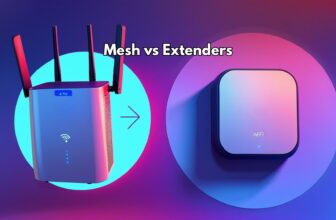The Mystery Of Mesh: How Does Mesh Wi-Fi Work?
Having a reliable and high-speed Wi-Fi network is almost impossible to avoid in today’s connected world. Traditional Wi-Fi networks, often relying on a single router, can have limitations in terms of coverage and performance, especially in larger homes or offices. However, with the advancement in wireless technology, a new solution called Mesh Wi-Fi has emerged to address these issues.
Understanding Traditional Wi-Fi Networks
Before diving into how Mesh Wi-Fi works, let’s briefly understand the limitations of traditional Wi-Fi networks. In a typical setup, a single router serves as the central hub for transmitting internet signals to connected devices within its range. While this works well in smaller spaces, it becomes challenging to maintain a consistent and strong connection in larger areas or buildings with multiple walls and obstacles.
What is Mesh Wi-Fi?
Mesh Wi-Fi is a modern wireless networking solution that extends the coverage of your Wi-Fi network by using multiple devices, known as nodes or access points, placed strategically throughout your home or office. These nodes work together to create a seamless, reliable, and high-performance network that eliminates dead zones and ensures a smooth internet experience across all connected devices.
How Mesh Wi-Fi Differs from Traditional Wi-Fi
The primary difference between Mesh Wi-Fi and traditional Wi-Fi lies in their network architecture. While traditional Wi-Fi relies on a single router, Mesh Wi-Fi uses a system of interconnected nodes to create a “mesh” of Wi-Fi coverage. This mesh network communicates with each other, ensuring that data packets are efficiently delivered to the intended destination.

How Does Mesh Wi-Fi Work?
Mesh Nodes and Communication
Each node in a Mesh Wi-Fi system acts as a point of access for devices within its range. These nodes communicate with one another, forming a network of interconnections. When a device connects to the Mesh Wi-Fi network, it can seamlessly switch between nodes as it moves around the premises. This dynamic routing allows for a stable connection, reducing the chances of dropped signals or interruptions.
Smart Routing and Self-Healing
Mesh Wi-Fi systems employ intelligent routing algorithms to determine the most efficient path for data transmission. If one node becomes unavailable or experiences interference, the system automatically reroutes data through an alternative path, ensuring a self-healing network that optimizes performance and reliability.
Benefits of Mesh Wi-Fi
The implementation of a Mesh Wi-Fi system brings several advantages, such as:
- Expanded Coverage: Mesh Wi-Fi eliminates dead spots and extends coverage to every corner of your property.
- Consistent Performance: Users experience stable and reliable internet connectivity throughout the network.
- Scalability: You can easily expand your Mesh Wi-Fi network by adding more nodes to accommodate a growing number of devices.
- Easy Setup: Most Mesh Wi-Fi systems come with user-friendly mobile apps that guide you through the installation and configuration process.
TP-Link Deco AX3000 WiFi 6 Mesh System(Deco X55) - Covers up to...
& Free shippingSetting Up a Mesh Wi-Fi Network
Choosing the Right Mesh System
When selecting a Mesh Wi-Fi system, consider factors like coverage area, number of devices, and internet speed requirements. Different systems offer various features, so choose one that best suits your needs.
Installation and Configuration
The installation of a Mesh Wi-Fi network usually involves connecting one node to your existing modem and strategically placing additional nodes throughout your home or office. The mobile app or web interface guides you through the setup process.
Best Practices for Optimal Performance
To get the most out of your Mesh Wi-Fi system, follow these best practices:
- Place nodes in open areas, away from obstructions, to improve signal strength.
- Regularly update the firmware to ensure the latest security patches and performance enhancements.
Google Wifi - AC1200 - Mesh WiFi System - Wifi Router -...
& Free shippingMesh Wi-Fi vs. Wi-Fi Range Extenders
While both Mesh Wi-Fi systems and Wi-Fi range extenders aim to improve coverage, they have different approaches and advantages.
Pros and Cons
Wi-Fi Range Extenders:
- Pros: Cost-effective solution, easy to set up.
- Cons: Can lead to network performance degradation and limited range extension.
Mesh Wi-Fi Systems:
- Pros: Seamless roaming, self-healing network, consistent performance.
- Cons: Generally more expensive than range extenders.
Which One to Choose?
The decision between Mesh Wi-Fi and Wi-Fi range extenders depends on your specific needs. For larger spaces and better performance, Mesh Wi-Fi is the recommended choice.
NETGEAR Nighthawk Whole Home Mesh WiFi 6 System (MK62) - AX1800 router...
& Free shippingMesh Wi-Fi Security Considerations
With any Wi-Fi network, security is a top concern. Here are some security considerations for your Mesh Wi-Fi network:
Encryption and Authentication
Ensure that your Mesh Wi-Fi system uses strong encryption protocols like WPA3 and secure authentication methods to protect your network from unauthorized access.
Protecting Your Network
Regularly update your network’s security settings and passwords. Additionally, enable features like guest networks and parental controls for added security.
TP-Link Deco Mesh WiFi System(Deco M5) –Up to 5,500 sq. ft. Whole...
& Free shippingFuture of Mesh Wi-Fi Technology
As technology continues to advance, Mesh Wi-Fi systems will likely see further improvements. Expect advancements in speed, range, and seamless integration with other smart devices in the home or office.
Conclusion
Mesh Wi-Fi is a game-changer for those seeking a robust and reliable wireless network. By leveraging a mesh network of interconnected nodes, Mesh Wi-Fi eliminates dead spots and offers consistent connectivity throughout your property. With its ease of setup and impressive performance, it’s no wonder that Mesh Wi-Fi is becoming increasingly popular.
FAQs
- Q: Can I use my existing Wi-Fi router with a Mesh Wi-Fi system? A: Yes, most Mesh Wi-Fi systems can be used in conjunction with your existing router.
- Q: How many nodes do I need for my Mesh Wi-Fi network? A: The number of nodes required depends on the size and layout of your property. A typical setup may include three nodes.
- Q: Can Mesh Wi-Fi improve gaming performance? A: Yes, Mesh Wi-Fi’s stable and consistent connection can enhance gaming experiences.
- Q: Is Mesh Wi-Fi suitable for businesses? A: Absolutely! Mesh Wi-Fi is an excellent solution for businesses seeking seamless connectivity across their premises.
- Q: Can I expand my Mesh Wi-Fi network in the future? A: Yes, Mesh Wi-Fi systems are scalable, allowing you to add more nodes as needed to accommodate additional devices.
Last update on 2025-10-10 at 20:52 Affiliate links and Images from Amazon Product Advertising API











































